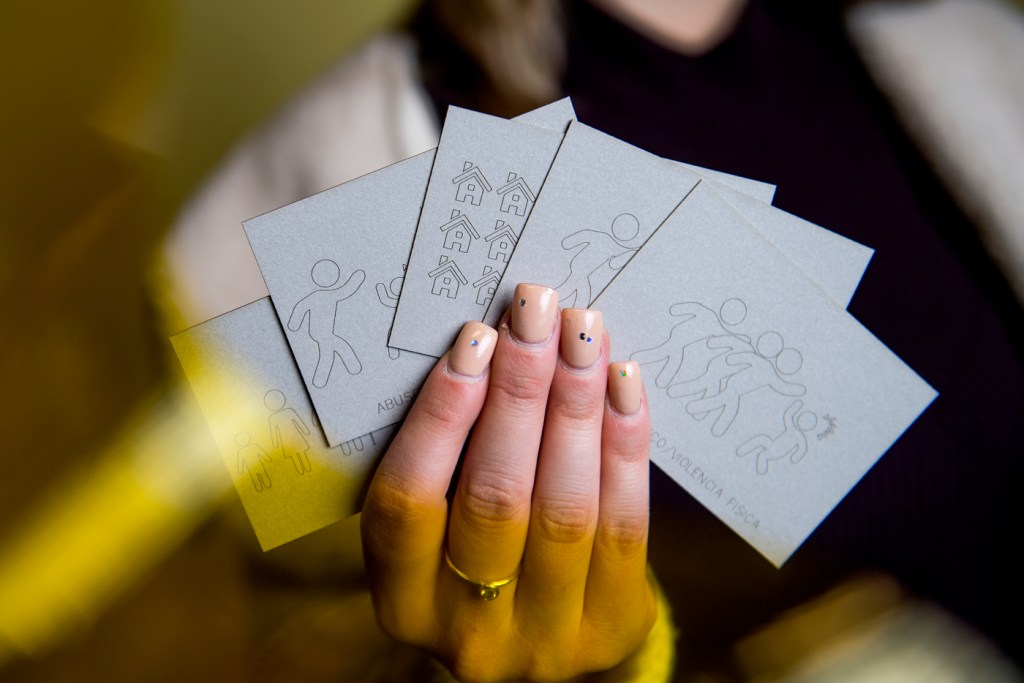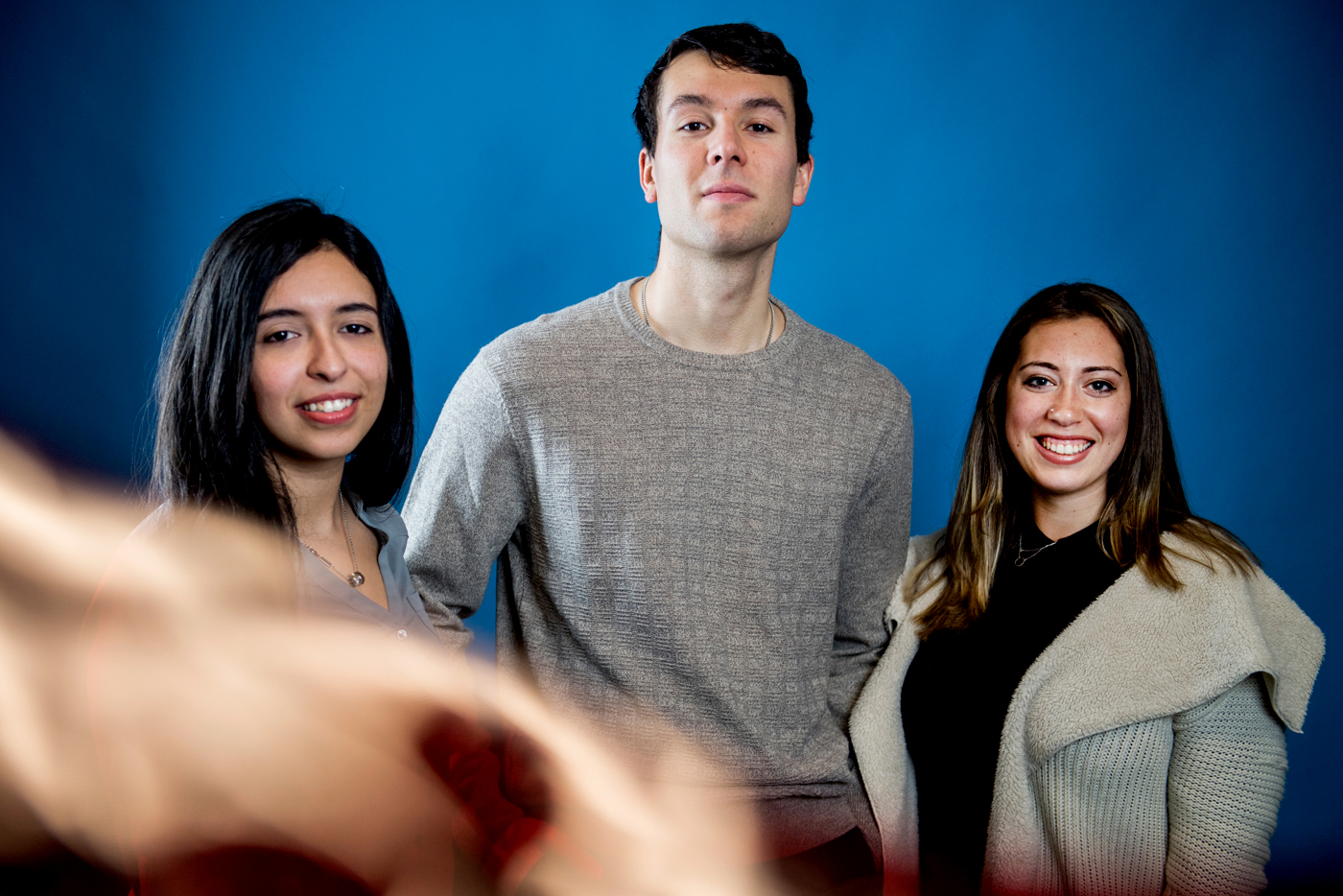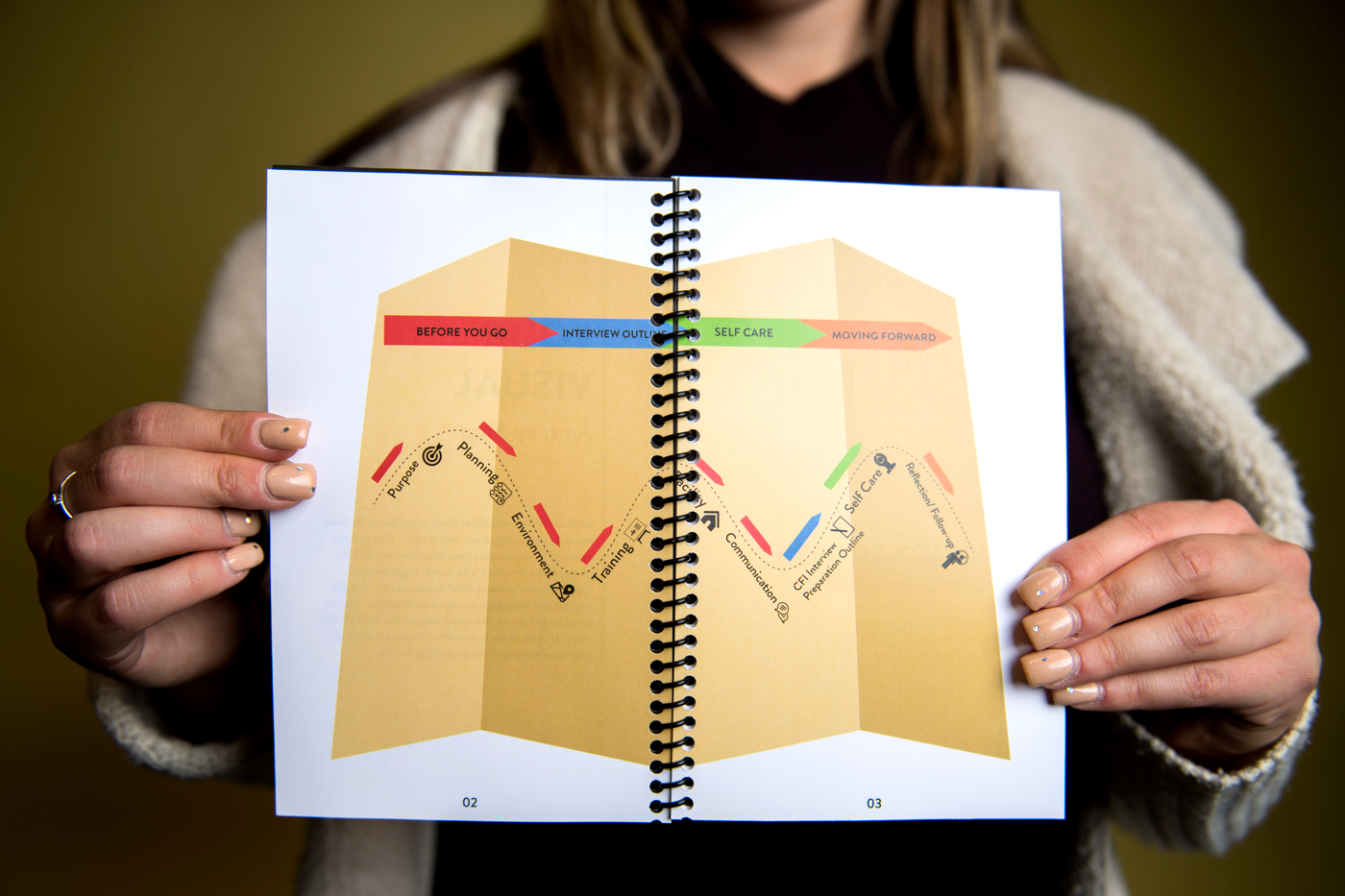Northeastern University art students create training manual to help law students prepare asylum seekers for their credible fear interviews

After migrants flee their home countries to seek protection in the United States, they must meet with an asylum officer. The migrants have to show that they would likely face persecution if they were to return home because of their race, religion, nationality, political opinions, or membership in a particular social group.
The majority of asylum seekers pass the screening, known as the credible fear interview, but the stakes are high. If an asylum officer finds that someone’s “credible fear” is valid, they refer the case to an immigration court for a full hearing. If not, the person is ordered to be deported.

Lina Alaoui, Colin Gerrity, and Leah Kleiman developed a booklet and flash cards to help asylum seekers at the United States southern border tell their stories. Photo by Matthew Modoono/Northeastern University
Now, eight Northeastern law students are volunteering at the U.S. southern border in Dilley, Texas, to help asylum seekers prepare for their credible fear interviews. The law students, in Dilley from May 19 to May 24, are working with asylum seekers through the Dilley Pro Bono Project, which organizes groups of volunteers to provide a range of legal services for detainees at the South Texas Family Residential Center.
“I believe that it’s critical to give people as much information as possible for them to feel confident in advocating for themselves and making decisions that are best for themselves and their families,” says Zoe Bowman, a first-year law student who is helping the asylum seekers prepare for their screenings.
The Northeastern law students are using a training manual—developed by other Northeastern students in the School of Law and the College of Arts, Media and Design—to help guide them throughout the experience.
The manual includes strategies for volunteers to help asylum seekers share their stories and communicate why they need protection in the U.S. during their credible fear interviews. It also contains tips and activities designed to help the students prepare for and reflect on the experience, and cope with the emotional intensity of working with asylum seekers who are sharing stories of personal trauma and fear.
The manual comes with flash cards depicting illustrated representations of people, places, actions, and items that volunteers can use to help asylum seekers express themselves if they’re having difficulty discussing and describing their experiences. Some cards feature illustrations of family members, authority figures, and weapons. Some show locations such as a house, hospital, airport, prison, farm, or church. And some depict acts of physical, sexual, or emotional abuse.

(L-R) Sarah Kanouse, associate professor in the Department of Art + Design, and Jules Sievert, creative director at the NuLawLab. Photos by Matthew Modoono/Northeastern University
The numbers of migrants crossing the U.S. southwest border have reached all-time highs in recent months. The increase comes as the Trump administration takes steps to place more restrictions, including application fees and work permit restraints, on asylum seekers at the southern border. U.S. Attorney General William Barr also decided in April that asylum seekers who pass their credible fear interviews are ineligible to be released on bond as they await the results of their hearings.
About 76 percent of asylum seekers passed their credible fear interviews in the 2018 fiscal year, according to U.S. Citizenship and Immigration Services data. A much lower percentage, however, are eventually granted asylum by immigration judges.
‘A great example of interdisciplinary work’
Over the past nine months, Northeastern students studying law have worked with their peers studying the arts to develop the booklet. That work began in the fall when Dan Jackson and Jules Rochielle Sievert merged a law seminar they were teaching with a course taught by Sarah Kanouse, an associate professor in the Department of Art + Design.
Jackson and Kanouse say that the partnership forced art students to consider legal principles and compelled law students to consider how to present complex concepts through a creative lens.
“This is a great example of interdisciplinary work,” says Jackson, who is the executive director of the NuLawLab, which designs, tests, and produces new approaches to helping people understand and exercise their legal rights.
Lina Alaoui, who was a master’s student in the College of Arts, Media and Design at the time of the project, says that she wanted to take the course to learn more about what happens to asylum seekers at the U.S. southern border. She says that she also wanted to work on a project with immediate real-world applications.
“I want to make sure that this works,” says Douiri, who graduated in May. “I felt like that made me and others more dedicated and invested.”
Students, faculty, and staff have spent the past few months refining the materials and evaluating how they’ll be used. They tested the materials by holding a series of mock interviews between the law students who will be helping to prepare asylum seekers for their credible fear interviews and a Northeastern theater student, who played the role of asylum seeker.
Jackson says that he wants to provide the manual to other volunteers who will help to prep asylum seekers for their credible fear interviews in the future. Bowman says that she will collect feedback from her fellow law students who are working with the manual in order to further refine the materials in the coming months.
‘You come into people’s lives at this extraordinary moment’
Ilana Greenstein, an adjunct faculty member in the School of Law, who is overseeing the Northeastern law students in Dilley, says that her work with asylum seekers has been among the most rewarding experiences of her professional life.

The manual contains tips and activities designed to help the students cope with the emotional intensity of working with asylum seekers who share stories of personal trauma and fear. Photo by Matthew Modoono/Northeastern University
This marks her fourth trip—the first of which was in 2015—to help asylum seekers in Dilley prepare for their credible fear interviews.
“You come into people’s lives at this extraordinary moment,” says Greenstein, who has practiced immigration law for the past 20 years and works for the Immigration Justice Campaign, which provides pro-bono legal representation to immigrants in detention. “For students to be able to experience that and do something that is so immediate and intense is really, I hope, going to be great for them.”
For media inquiries, please contact Shannon Nargi at s.nargi@northeastern.edu or 617.373.5718.





